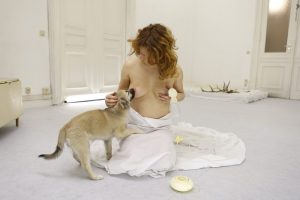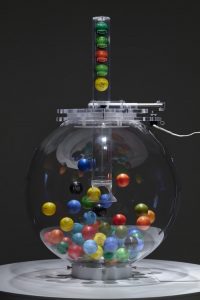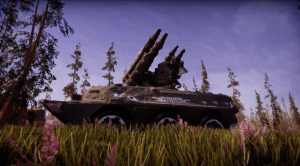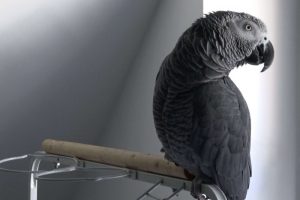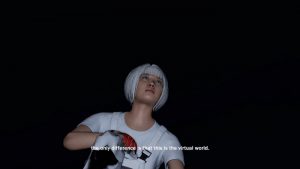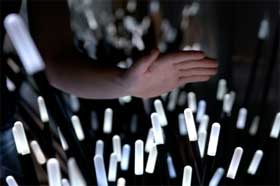 Dune 4.0, developed by Daan Roosegaarde, is an interactive landscape which physically changes its appearance in accordance to human presence.
Dune 4.0, developed by Daan Roosegaarde, is an interactive landscape which physically changes its appearance in accordance to human presence.
Placed in the main corridor of Montevideo (Amsterdam, NL), Dune 4.0 is composed of hundreds of fibers which react to the movements and sounds made by the visitors. This hybrid of nature and technology functions as a platform on which the relationship between visitor and the existing architecture is enhanced. By means of looking, walking and interacting, visitor and space merge into one coherent environment which could be best interpreted as a kind of “Alice in Technoland”.
Dune 4.0 is currently further developed for a public site besides the river Maas in Rotterdam.
It’s not the first time i mention Roosegaarde‘s projects. He has previously designed, among other projects, 4d pixel, a smart surface which physically reacts to your voice, music and can write relievo letters and Liquid 2.0, a living cocoon which physically reacts to your motion and sounds. This time i decided to ask him a few questions about his latest piece.
How do the fibers react to movement exactly? Light, sound, movement?
Dune 4.0 is an interactive landscape which reacts to the sounds and motion of the visitors as they walk through the corridor of the museum. Inside the installation, several microphones and presence sensors detect human activity. The specially developed software regulates this and gives an output to the electronics.
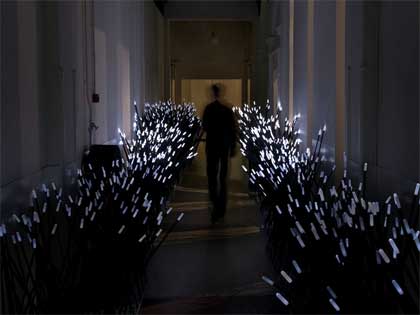
The output is based 70% on the motion and 30% on the sounds of the visitor. The beauty of the software is that it is constantly tuning itselve dynamically; if there is a ventilator making a “zooming” noise all the time, the software realizes it has been there for a while and starts to ignore it. This way the installation always stays fresh for new input of the visitor. All this addresses the hundreds of fibers.
According to human activity we have 128 steps in tuning the lights. So no ‘on’ nor ‘off’- it’s all about making a scape which moves with you. There are several moods within the landscape; when nobody is there, it will fall asleep –glooming softly– but then as soon as you enter Dune 4.0 light appears where you walk, as an extension of your activities. But it’s not all soft and gloomy; when you make a lot of noise the landscape goes crazy- lightning crashes. Dune 4.0 has been in the corridor for 6 weeks so we are really able to look how people react to the installation and then go back to the software and tune or emphasize -we want it to learn how to behave and to become more sensitive towards the visitor. These type of projects are never finished. Good things take time…. and your social life grrrr.
Do you see that particular work as a piece of art or interaction design (or something else)?
The project is a fusion of art & technology which will be implemented into architecture. I perhaps find it more interesting that you ask me this question since it means that Dune 4.0 is a work which can be several things in one. As a sculptor/architect, making installations is like having a taste in your mouth of which you do not know the ingredients. It is here where you start to explore -reading, writing, travelling, building- whatever is necessary to get those bloody ingredients. For me technology became a tool just as a piece of crayon could be. It is a physical consequence of this exploration; of the making which makes me.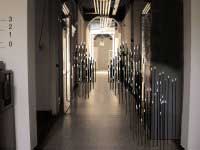 How do visitors react to the installation?
How do visitors react to the installation?
For me this is the best part of making these kind of installations; the interaction with the visitors. There is a hard construction (the materials, the present architecture) and a soft construction (the software and the human behavior). Where they meet form begins to arise.
While watching how people react on the work I realized this: the main ingredient is the human interaction itself. I have been talking about this earlier, that I would like to invite the visitor to become a participant instead of an observer. But with Dune 4.0 it goes one step further; the visitor becomes a performer. Once we had Abramovic doing performances while an audience was watching. But here the audience becomes an essential element of the identity of the work itself. All this happens in a supernatural environment; you are walking through a corridor. It is here that all the technology merges with your body, as a realtime extension of your skin -feeling like an ‘Alice in Technoland’.
Yesterday there were an old lady making barking sounds. And not one time but several times; pretty loud. I asked her why she was doing this and she replied that she had a little dog at home. She was wondering how Dune 4.0 would react when her dog would bark and that’s why she was testing the sounds.
Looking at these things I sometimes ask myself who is the real artist here but that is another story :) That’s what I like: that people start to personalize the work.
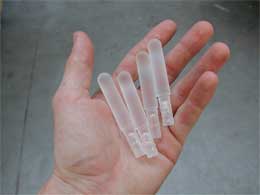 Would you mind telling me a bit more details about the technology behind the work?
Would you mind telling me a bit more details about the technology behind the work?
Dune 4.0 is part of a series interactive installations I make called ‘Liquid constructions’. There is Liquid Space, 4D-Pixel, Liquid 2.0, Wind 3.0, Dune 4.0 and for the U3 Triennale in Slovenia we are building Flow 5.0. The installations are exhibited at shows but the final goal is to implement them into public space and architecture. Therefore I recently launched Studio Roosegaarde which explores the dynamic relation between architecture, people and new media. Together with software engineers, material manufacturers and cultural foundations we are capable to develop interactive installations which have a healthy balance between fantasy and budget.
I like the idea of a serie since I learn from making projects and you want this knowledge to ‘copy-morph’ (not copy-paste!); in a constant attempt to make works which are more sensitive towards the visitor in a public environment. The main goal is to make work which acts as a second layer of information and experience, over the existing architecture.
The movie of Dune 4.0 will be online in the beginning of January. In the meantime check out Daan’s brand new website. Friday afternoon, December 15, Daan Roosegaarde’s work will be further discussed at Montevideo during the seminar ‘The body as interface, the function and presentation of interactivity’.

